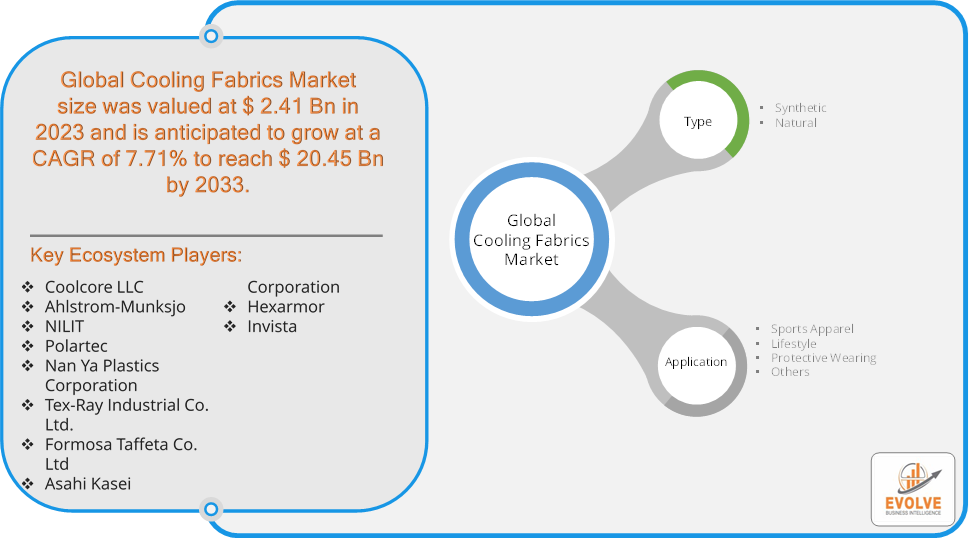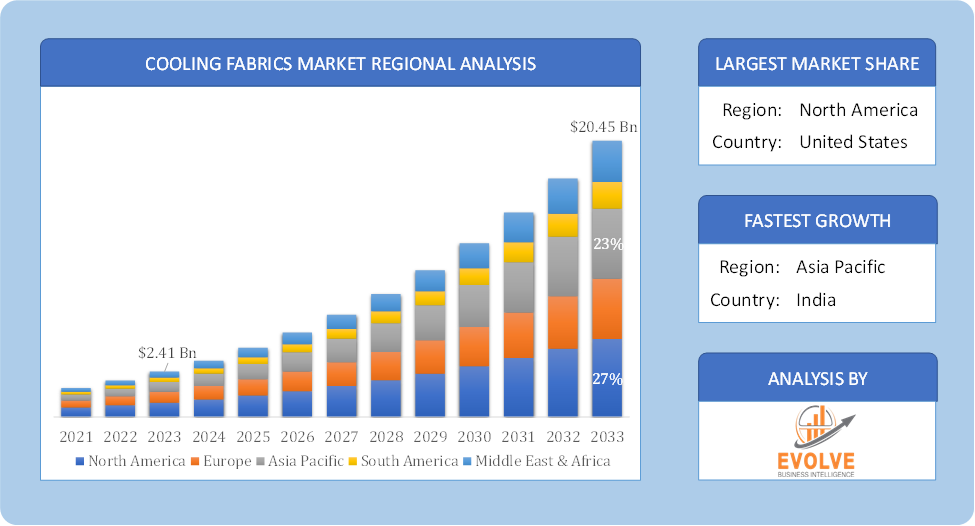Cooling Fabrics Market Analysis Overview
The Cooling Fabrics Market Analysis Size is expected to reach USD 20.45 Billion by 2033. The Cooling Fabrics Market Analysis industry size accounted for USD 2.41 Billion in 2023 and is expected to expand at a compound annual growth rate (CAGR) of 7.71% from 2023 to 2033. The Cooling Fabrics Market Analysis involves examining the market dynamics, trends, and factors influencing the demand and supply of cooling fabrics. Cooling fabrics are textiles engineered to provide a cooling effect to the wearer by using various technologies and materials to enhance comfort and regulate body temperature.
The primary goal of cooling fabrics market analysis is to provide valuable insights for businesses, investors, and policymakers to make informed decisions. The cooling fabrics market analysis provides a comprehensive overview of the industry, enabling stakeholders to navigate the market effectively and capitalize on growth opportunities.
Global Cooling Fabrics Market Analysis Synopsis
 COVID-19 Impact Analysis
COVID-19 Impact Analysis
The COVID-19 pandemic had significant impacts on the Cooling Fabrics Market. Lockdowns and restrictions led to temporary closures of manufacturing facilities, affecting the production of cooling fabrics. Transportation restrictions and delays affected the distribution and delivery of finished products. Economic uncertainty and reduced disposable income led to decreased spending on non-essential items, including specialty clothing and cooling fabrics. The pandemic heightened awareness of health and comfort, driving innovation in textiles. Cooling fabrics with antimicrobial properties and enhanced comfort features saw increased interest. The shift to remote work and increased time spent at home led to a rise in demand for comfortable, leisure, and homewear, which includes cooling fabrics. The rise in online shopping during the pandemic boosted the e-commerce channels for cooling fabrics, as consumers turned to online platforms for purchasing apparel and textiles. The cooling fabrics market is expected to recover as global conditions stabilize. The pandemic has underscored the need for adaptable and resilient supply chains, which may drive long-term improvements.
Cooling Fabrics Market Analysis Dynamics
The major factors that have impacted the growth of Cooling Fabrics Market Analysis are as follows:
Drivers:
Ø Advancements in Textile Technology
Development of new cooling technologies, such as phase change materials (PCMs) and cooling fibers, enhances the functionality and appeal of cooling fabrics. Ongoing R&D efforts lead to better performance, durability, and cost-effectiveness of cooling fabrics. The integration of advanced manufacturing technologies enables the production of high-performance cooling fabrics at scale. The development of smart textiles that integrate cooling functions with other features (e.g., sensors, connectivity) creates new opportunities in the market. There is growing demand for sustainable and eco-friendly textiles, which drives the development of cooling fabrics made from recyclable or low-impact materials.
Restraint:
- Perception of High Production Costs and Consumer Awareness
The cost of advanced materials and technologies used in cooling fabrics, such as phase change materials (PCMs) and specialized fibers, can be high. The production process for cooling fabrics often involves sophisticated techniques and equipment, contributing to increased costs. Lack of awareness about the benefits and availability of cooling fabrics can limit market growth. Consumers may not fully understand the advantages of these fabrics over traditional textiles.
Opportunity:
⮚ Innovation and Technological Advancements
Developing advanced cooling technologies, such as improved phase change materials (PCMs), enhanced moisture-wicking fibers, and smart textiles with integrated cooling functions, can drive market growth. Investing in R&D to create high-performance and cost-effective cooling fabrics can lead to new product offerings and competitive advantages. Developing sustainable cooling fabrics made from recyclable, biodegradable, or eco-friendly materials aligns with increasing consumer demand for environmentally responsible products. Targeting environmentally aware consumers with products that offer both performance and sustainability can enhance brand appeal and marketability.
Cooling Fabrics Market Analysis Segment Overview
 By Type
By Type
Based on Type, the market is segmented based on Synthetic and Natural. The synthetic segment dominant the cooling fabrics market because of its superior moisture and cooling management capabilities. Synthetic fabric is becoming more popular for making sports equipment and protective clothing since it is more durable, strong, and cost-effective than natural fabric. Due to their widespread availability and lightweight nature, synthetic fibres like spandex, nylon, and polyester are commonly favoured when producing synthetic cooling materials.
By Application
Based on Application, the market segment has been divided into Sports Apparel, Lifestyle, Protective Wearing and Others. The sports apparel segment dominant the market. The popularity of outdoor sports and fitness activities is developing as a result of consumers’ growing health awareness due to the incidence of chronic diseases. Thus, it is assisting in driving up demand for sports gear comprised of breathable materials. As they aid in keeping the body at a reasonable temperature during strenuous activity and hot weather, cooling textiles are being used more and more in the production of athletic wear.
Global Cooling Fabrics Market Analysis Regional Analysis
Based on region, the global Cooling Fabrics Market Analysis has been divided into North America, Europe, Asia-Pacific, the Middle East & Africa, and Latin America. North America is projected to dominate the use of the Cooling Fabrics Market Analysis followed by the Asia-Pacific and Europe regions.
 Cooling Fabrics North America Market
Cooling Fabrics North America Market
North America holds a dominant position in the Cooling Fabrics Market Analysis. North America, particularly the United States and Canada, is a significant market for cooling fabrics due to advanced technology adoption and high consumer awareness. Increased demand for performance and sportswear, growing awareness of health and wellness, and advancements in textile technology. High adoption of cooling fabrics in sports and activewear, as well as growing interest in smart textiles and sustainable products.
Cooling Fabrics Asia-Pacific Market
The Asia-Pacific region has indeed emerged as the fastest-growing market for the Cooling Fabrics Market Analysis industry. Asia-Pacific is one of the fastest-growing regions for cooling fabrics, with significant potential due to rapid urbanization and rising disposable incomes. Increasing heat exposure, growing outdoor and sports activities, and expanding middle-class population and rising demand for cooling fabrics in sports and leisurewear, increased focus on health and wellness, and growing e-commerce channels.
Competitive Landscape
The global Cooling Fabrics Market Analysis is highly competitive, with numerous players offering a wide range of software solutions. The competitive landscape is characterized by the presence of established companies, as well as emerging startups and niche players. To increase their market position and attract a wide consumer base, the businesses are employing various strategies, such as product launches, and strategic alliances.
Prominent Players:
- Coolcore LLC
- Ahlstrom-Munksjo
- NILIT
- Polartec
- Nan Ya Plastics Corporation
- Tex-Ray Industrial Co. Ltd.
- Formosa Taffeta Co. Ltd
- Asahi Kasei Corporation
- Hexarmor
- Invista
Scope of the Report
Global Cooling Fabrics Market Analysis, by Type
- Synthetic
- Natural
Global Cooling Fabrics Market Analysis, by Application
- Sports Apparel
- Lifestyle
- Protective Wearing
- Others
Global Cooling Fabrics Market Analysis, by Region
- North America
- US
- Canada
- Mexico
- Europe
- UK
- Germany
- France
- Italy
- Spain
- Benelux
- Nordic
- Rest of Europe
- Asia Pacific
- China
- Japan
- South Korea
- Indonesia
- Austalia
- Malaysia
- India
- Rest of Asia Pacific
- South America
- Brazil
- Argentina
- Rest of South America
- Middle East & Africa
- Saudi Arabia
- UAE
- Egypt
- South Africa
- Rest of Middle East & Africa
| Parameters | Indicators |
|---|---|
| Market Size | 2033: USD 20.45 Billion |
| CAGR (2023-2033) | 7.71% |
| Base year | 2022 |
| Forecast Period | 2023-2033 |
| Historical Data | 2021 (2017 to 2020 On Demand) |
| Report Coverage | Revenue Forecast, Competitive Landscape, Growth Factors, and Trends |
| Key Segmentations | Type, Application |
| Geographies Covered | North America, Europe, Asia-Pacific, South America, Middle East, Africa |
| Key Vendors | Coolcore LLC, Ahlstrom-Munksjo, NILIT, Polartec, Nan Ya Plastics Corporation, Tex-Ray Industrial Co. Ltd., Formosa Taffeta Co. Ltd, Asahi Kasei Corporation, Hexarmor and Invista. |
| Key Market Opportunities | · Innovation and Technological Advancements · Sustainability and Eco-Friendly Solutions |
| Key Market Drivers | · Advancements in Textile Technology · Technological Integration in Manufacturing |
REPORT CONTENT BRIEF:
- High-level analysis of the current and future Cooling Fabrics Market Analysis trends and opportunities
- Detailed analysis of current market drivers, restraining factors, and opportunities in the future
- Cooling Fabrics Market Analysis historical market size for the year 2021, and forecast from 2023 to 2033
- Cooling Fabrics Market Analysis share analysis at each product level
- Competitor analysis with detailed insight into its product segment, Government & Defense strength, and strategies adopted.
- Identifies key strategies adopted including product launches and developments, mergers and acquisitions, joint ventures, collaborations, and partnerships as well as funding taken and investment done, among others.
- To identify and understand the various factors involved in the global Cooling Fabrics Market Analysis affected by the pandemic
- To provide a detailed insight into the major companies operating in the market. The profiling will include the Government & Defense health of the company’s past 2-3 years with segmental and regional revenue breakup, product offering, recent developments, SWOT analysis, and key strategies.


 Cooling Fabrics North America Market
Cooling Fabrics North America Market

